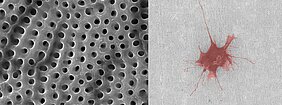Titanium dioxide nanotube scaffolds already have a wide range of applications and are also increasingly showing great potential in the field of brain research. These hexagonal arranged tubes on nanometer scale strongly remind of a honeycomb structure under the microscope become more and more important for biomedical research due to their eminent biocompatibility. Depending on the field of application, these scaffolds can be tailored by changing the manufacturing parameters as well as by modifying the surface via post-treatment. Accordingly, modification of these scaffolds by targeted ion bombardment demonstrated that their electrical conductivity can be positively and precisely adjusted. This circumstance has now been exploited by researchers from the Department of Biocompatible and Bioactive Surfaces at the Leibniz Institute for Surface Engineering to expand their medical field of application. They investigated the influence of ion implantation on the interaction of important proteins and cells of the human brain to explore the first principles for brain-computer interfaces. They found that ion implantation does not impact the adhesion as well as cell viability of neurons, but suppresses the over-accumulation of glial cells that are also present in the brain. This results in a promising approach for the elucidation and symptomatic treatment of neurodegenerative diseases that are not fully comprehended so far explains Jan Frenzel, research scientist on the project. Additionally, the adsorption of an important protein in the brain, laminin, could be described by linking it to important surface parameters. These findings will enable us in the future to adjust surface parameter to maximize protein adsorption additionally to improve cell adhesion comments the head of the research area Prof. Dr. Stefan Mayr.
The scientists present their results in the peer-reviewed journal Nanomaterials. Further information about the article:
J. Frenzel, A. Kupferer, M. Zink, S.G. Mayr
Laminin Adsorption and Adhesion of Neurons and Glial Cells on Carbon Implanted Titania Nanotube Scaffolds for Neural Implant Applications
Nanomaterials2022, 12 (21), 3858
https://doi.org/10.3390/nano12213858

